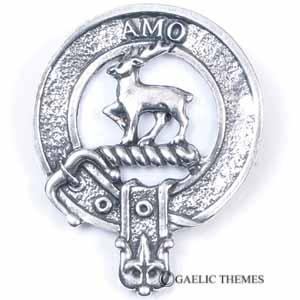Scott
Select
- Design: Standard
- Clan Motto: Amo (I Love)
- Notes:
Crest: A stag trippant Proper, attired and unguled Or
The Latin word ‘Scotti’ originally referred to the irish Celts and later to the Gaels. The earliest charter record of the word used as a name is Uchtred ‘Filius Scott’ in 1120. Then there was Henricus le Scotte in 1195. In the early 13th century, a master Isaac Scotus witnessed charters by the Bishop of St. Andrews.
Four generations after Uchtred, Sir Richard Scott married the heiress of Murthockstone, acquiring those estates, and was appointed ranger of Ettrick Forest which added the lands of Rankilburn. Richard built a house at Buccleuch and the name was applied to his lands generally.
The second laird of Buccleuch, Michael, fought for Robert the Bruce and distinguished himself at the battle of Halidon Hill in 1333. He was among the few who survived the day, but later was felled at Durham in 1346.
Succeeding lairds added more to the clan lands over the years, including Branxholm. The sixth laird Scott was active in the Crown’s effort to suppress the powerful Douglas faction and was rewarded with Douglas lands. In 1463, Branxholm became a free barony held on the payment to the Crown of one red rose on the feast day of St. John the Baptist.
By 1500, the Scotts were among the most powerful Borders clans. The chief had literally a thousand spears to enforce his will. A feud erupted with the Kerrs of Cessford when Sir Walter Scott of Buccleuch tried to free a young James V, then held in captivity by Earl of Angus at Darnick. IN 1547, Scott attacked and Kerr of Cessford was killed (Sir Walter was also wounded). Buccleuch also fought at Pinkie in 1547. Four years on, he was made warden of Liddledale and the Middle Marches. On October 4, 1552, the Kerrs ambushed Sir Walter on the High Street in Edinburgh and killed him. The feud only ended when Sir Thomas Kerr of Ferniehirst married Janet Scott, sister of the tenth laird of Buccleuch.
When James VI ascended to the throne, a campaign to pacify the Borders was begun. Lord Walter Scott (known as ‘Bold Buccleuch’) took the opportunity to relax abroad -- fighting in the Netherlands for the Prince of Orange. His son fought against the Spanish in Holland and was made Earl of Buccleuch in 1619.
The second Earl, Francis, was a Covenanter and led a regiment of horse against Montrose at Philiphaugh. Francis diedat age twenty-five leaving the estate to his four-year-old daughter Mary. She was married to Walter Scott of Highchester at the age of eleven but died in 1661, age fourteen.
Mary’s sister Anne inherited. Charles II sought her hand for his illegitimate son James, Duke of Monmouth. Monmouth assumed the name of Scott and he and his young bride were named Duke and Duchess of Buccleuch. James rose against the Crown and was executed in 1685. Anne’s status was unaffected and so the title passed to her grandson, Francis, second Duke of Buccleuch.
The family has prospered since and today is noted for the internationally renowned art collection displayed at the family houses of Drumlanrig, Bowhill and Boughton.
